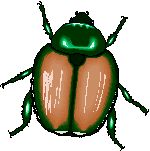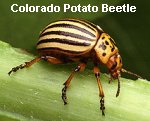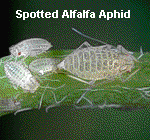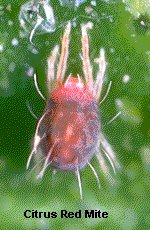Pest Management

There are basically two venues for pest control — agricultural and urban/industrial. In homes and businesses, tolerance for insect pests is very low. Pest control objectives are best described as: Locate and Kill. Heavy emphasis is placed on excluding or eradicating pests, or creating environments where pest species cannot survive and reproduce. In agricultural settings, where exclusion or eradication is less practical, the objective is often to reduce pest populations to levels that are compatible with human interests and economics. The term pest management was coined in the 1960’s to reflect this current emphasis on coexistence rather than eradication. Management strategies include not only the traditional physical and chemical weapons that kill insects, but also a wide variety of non-lethal cultural and biological tactics that will be discussed in the next chapter.
 Effective pest management usually follows a logical progression of steps to identify and solve a pest problem:
Effective pest management usually follows a logical progression of steps to identify and solve a pest problem:
- Identification — Exactly which species is causing damage? The cause is not always obvious or easy to determine, particularly if it involves transmission of disease. Some pest species are very similar in appearance to non-pest species, and confusing the two may result in unnecessary expense for pest control.
- Quantification — What is the density and/or distribution of the population? Use of survey and sampling techniques allows an assessment of whether or not the problem is severe enough to warrant the time and expense of control efforts.
- Specification — What is the most reasonable and effective course of action? Find out what experts would recommend. Control recommendations are often available from agricultural extension services
- Application — Implement the appropriate management tactic. Whenever chemical insecticides are used, it is important that label directions be followed precisely. Adequate consideration must be given to safety of the applicator as well as to protection of non-target organisms and the general environment.
- Evaluation — How effective was the control operation? Assessment of pest population density must be conducted after the management tactic has had time to have its impact on the pest.
 Insect pests can be grouped into three general categories based on how frequently humans must take control action against them. The numbers in parentheses at the end of each group are estimates by the National Academy of Science (1969) for the number of North American species that fall into each group.
Insect pests can be grouped into three general categories based on how frequently humans must take control action against them. The numbers in parentheses at the end of each group are estimates by the National Academy of Science (1969) for the number of North American species that fall into each group.
- Severe or persistent pests. Only a small number of insect species are regular problems. These pests are typically small, mobile, and have a high reproductive potential. They reach injurious populations every year, and control strategies must be implemented regularly and consistently to prevent economic loss. Pests that transmit disease, injure high-value crops, or become a special nuisance would also be grouped as severe pests. [150 to 200 species: examples include the cotton boll weevil (Anthonomis grandis), codling moths (Cydia pomonella), Colorado potato beetles (Leptinotarsa decemlineata), Mexican bean beetles (Epilachna varivestis), and corn earworms (Helicoverpa zea).]
- Occasional or sporadic pests. These insects become pests only at specific times, under special conditions, or in certain places. They do not always require control and are often maintained at sub-economic levels by natural predators and parasites. Outbreaks typically occur whenever changes in cultural, ecological, or environmental conditions produce special opportunities for reproductive success. [400 to 500 species: examples include fall armyworms (Spodoptera frugiperda), green stinkbugs (Acrosternum hilare), potato leafhoppers (Empoasca fabae), white-fringed beetles (Graphognathus leucolema), hog lice (Haematopinus suis), and pharaoh ants (Monomorium pharaonis).]
- Uncommon or infrequent pests. There are many insect species which only become pests under the most unusual circumstances. These insects are not generally regarded as pests because a.) they are rarely encountered by humans, b.) they are not abundant enough to cause serious injury, or c.) they do not injure commodities or resources that are valued by humans. [6,000 species: examples include nutgrass billbugs (Sphenophorus cariosus), blueberry stem borers (Oberea myops), azalea caterpillars (Datana major), smut beetles (Phalacrus politus), and honeysuckle sawflies (Zaraea inflata).]
Pest Outbreaks
 Since all insect populations rise and fall with changes in the seasons, interspecific competition, food quality, and numerous other variables, it is important to recognize which ones are likely to become pests and to understand what factors might precipitate their explosive growth. Even the worst pest species are not continuous problems. Their status as pests is usually a function of abundance, distribution, or density. A few Japanese beetles on a grapevine would cause little concern, but an infestation that skeletonizes the leaves and attacks the fruit would not be tolerated.
Since all insect populations rise and fall with changes in the seasons, interspecific competition, food quality, and numerous other variables, it is important to recognize which ones are likely to become pests and to understand what factors might precipitate their explosive growth. Even the worst pest species are not continuous problems. Their status as pests is usually a function of abundance, distribution, or density. A few Japanese beetles on a grapevine would cause little concern, but an infestation that skeletonizes the leaves and attacks the fruit would not be tolerated.
Large, sporadic populations of insect pests are usually called outbreaks. They typically occur when the pest population rises significantly above its general equilibrium level and becomes a threat to human interests or endeavors. There are five common scenarios that lead to these pest outbreaks:
- environmental change
- introduction from abroad
- destruction of natural enemies
- development of resistance
- higher quality standards
Environmental Change
Most insect populations, with their large gene pool and high reproductive rate, are well-adapted to exploit changing conditions in the natural environment. Pest species are no exception. Changes in climate, habitat, or community structure (caused either by natural phenomena or human intervention) may provide an insect population with a reproductive opportunity that could change its status from endemic to epidemic within just a few generations.
 There are numerous examples of relatively minor insect species that have become important pests as a result of environmental change. In the early 1800’s, Leptinotarsa decemlineata was an inconsequential beetle that lived in the midwestern United States where it fed on buffalo burr, an unremarkable weed in the potato family. As European settlers emigrated to the midwest, they introduced Irish potatoes as an agricultural commodity. Within a few years, the prairie was dotted with potato fields and the little beetles that lived on buffalo burr soon discovered this new and very appetizing food source. Settlers quickly came to dread this native pest — it destroyed their potato fields, spread throughout other potato-growing regions, and is now recognized world-wide as a major pest: the Colorado potato beetle.
There are numerous examples of relatively minor insect species that have become important pests as a result of environmental change. In the early 1800’s, Leptinotarsa decemlineata was an inconsequential beetle that lived in the midwestern United States where it fed on buffalo burr, an unremarkable weed in the potato family. As European settlers emigrated to the midwest, they introduced Irish potatoes as an agricultural commodity. Within a few years, the prairie was dotted with potato fields and the little beetles that lived on buffalo burr soon discovered this new and very appetizing food source. Settlers quickly came to dread this native pest — it destroyed their potato fields, spread throughout other potato-growing regions, and is now recognized world-wide as a major pest: the Colorado potato beetle.
 The alfalfa butterfly (Colias eurytheme) presents a similar story. As a native of the southeastern U. S., this innocuous species fed on a variety of indigenous legumes until local farmers began planting fields of alfalfa. The butterfly quickly adopted alfalfa as a preferred host plant and has been an important pest of that crop ever since.
The alfalfa butterfly (Colias eurytheme) presents a similar story. As a native of the southeastern U. S., this innocuous species fed on a variety of indigenous legumes until local farmers began planting fields of alfalfa. The butterfly quickly adopted alfalfa as a preferred host plant and has been an important pest of that crop ever since.
By its very nature, modern agriculture provides opportunities for insect populations that they would never encounter under “natural” conditions. Cultivation of single plant species (e.g. cotton, corn, or soybeans) over large acreages (crop monoculture) promotes excellent survival and growth of pest populations, often well beyond their reproductive potential in natural communities or mixed-species plantings. To insect herbivores, these monocultures must seem like a Garden of Eden!
Virtually any agricultural practice that modifies a natural community is likely to create obstacles for some insect species and opportunities for others. Housing domestic animals in modern rearing facilities, for example, may reduce the potential for flea or lice infestations, but it may also compound the problems associated with waste disposal and fly control. Likewise, greenhouse operators can successfully exclude many insect pests, but species that do manage to breach the glass walls find an environment where temperature and humidity are nearly optimal throughout the year. Breeding crop plants for higher yields or better taste may produce a more saleable product, but it may also reduce the plant’s natural (native) resistance to insects. Even those piles of old tires that farmers keep behind the barn have become insect habitat — they hold just enough water to serve as breeding sites for a newly imported pest, the Asian tiger mosquito (Aedes albopictus).
Introduction from Abroad
We live in an increasingly mobile society. Expansion of international travel and trade continues to bring new opportunities for spread of insect pests from one part of the world to another. Much like pilgrims who came to America to escape religious oppression, these six-legged immigrants find a New World of opportunity free from parasites and predators. Some introduced species stake claim to an open niche in their new environment, others may outcompete or displace their native counterparts, and still others may adapt to new habitats or new host plants.
 The spotted alfalfa aphid (Therioaphis maculata) is an example of an opportunistic species that arrived in the United States from Mexico in 1954. Remarkable similarity in the genetic makeup of all aphids in the U.S. population led entomologists to speculate that the infestation may have been started by a single parthenogenetic female that landed in southeastern New Mexico, perhaps as a stowaway on an airplane that landed at Roswell Air Force Base. Enjoying a favorable climate, abundant food, and no natural enemies, the aphid population grew so rapidly that it spread into alfalfa fields from coast to coast in only three years.
The spotted alfalfa aphid (Therioaphis maculata) is an example of an opportunistic species that arrived in the United States from Mexico in 1954. Remarkable similarity in the genetic makeup of all aphids in the U.S. population led entomologists to speculate that the infestation may have been started by a single parthenogenetic female that landed in southeastern New Mexico, perhaps as a stowaway on an airplane that landed at Roswell Air Force Base. Enjoying a favorable climate, abundant food, and no natural enemies, the aphid population grew so rapidly that it spread into alfalfa fields from coast to coast in only three years.
More about
Exotic Pests It is not hard to find examples of introduced species that have become major pests in the United States — at latest count, more than 600 noxious species have invaded our shores. But we have also exported our share of insects, and many of these have become pests in foreign countries. The Colorado potato beetle and the apple maggot are two examples of North American species that are now regarded as important pests throughout much of Europe and Asia.
Destruction of Natural Enemies
 Pest populations often reach outbreak proportions if their native parasites and predators are suppressed or eradicated. Changes in management practices or alterations of the microclimate can have a great impact on the survival of natural enemies. Removing the ground cover from beneath apple trees, for example, can eliminate harborages and overwintering sites for the predators that help control scale insects and spider mites.
Pest populations often reach outbreak proportions if their native parasites and predators are suppressed or eradicated. Changes in management practices or alterations of the microclimate can have a great impact on the survival of natural enemies. Removing the ground cover from beneath apple trees, for example, can eliminate harborages and overwintering sites for the predators that help control scale insects and spider mites.
Beneficial insects are often unintended victims of insecticides used to control pest outbreaks. Destruction of these non-target populations may result in outbreaks of new pest species that were previously held in check by predation or parasitism. Following introduction of the cottony cushion scale into California, citrus farmers began using insecticides (primarily lime sulfur) to protect their crops from scale infestations. But in addition to killing the scale insects, insecticides also eliminated populations of natural predators that had always controlled the citrus red mite (Panonychus citri), a previously inconsequential herbivore. Many farmers had never seen red mite infestations until they began spraying for cottony cushion scale. Ultimately, the problem was resolved when entomologists imported and released the vedalia beetle (Rhodolia cardinalis) as a predator of the scale insects. Farmers were then able to eliminate most insecticide applications and mite predators eventually returned to the orchards.
When the insecticides used to control a pest population also kill or repel beneficial insects, it can be very difficult to reestablish the original balance of nature. In a sense, long-term control agents (natural enemies) are traded for short-term control agents (chemical insecticides). Once the effect of chemical control wears off, the pest population may “bounce back”, growing relatively unrestrained in an environment free of natural enemies. This phenomenon, known as resurgence, often forces the continued use of insecticides as a substitute for the missing natural enemies. In some cases, this vicious cycle can be hard to break.
Development of Resistance
Insect evolution did not stop at the end of the Mesozoic era. The forces of natural selection are just as active today in a cotton field as they were millennia ago in the primeval forest. When insect populations are exposed to selective pressures, whether natural or artificial, they change and adapt. Most of the control tactics we use to suppress insects are not 100% effective: they leave small numbers of survivors who manage to reproduce and pass on their genetic heritage to subsequent generations. When this genetic heritage includes genes (or alleles) that confer resistance, our control tactics will be less effective against future generations. Resistant populations may reach outbreak proportions quickly unless we change to newer, more effective controls. Resistance may be biochemical (e.g. an enzyme that degrades or detoxifies an insecticide), physiological (e.g. the ability to withstand greater environmental stress), or behavioral (e.g. the ability to avoid a poison or adapt to a new host plant). The genetic basis for resistance may be conferred by a single gene (dominant, co-dominant, or recessive), or it may be a result of phenotypic interaction of several genes (polygenic). Dominant or co-dominant resistance can spread quickly throughout a population. Recessive or polygenic resistance is often slower to develop, but it is also harder to eliminate or overcome.
 Insects that become resistant to one control strategy may also be resistant to other, related controls. This phenomenon, known as class-resistance, is commonly found within classes of insecticide. Insects that become resistant to aldicarb (Temik), for example, are usually also resistant to other carbamate insecticides, such as carbaryl (Sevin), carbofuran (Furadan), and propoxur (Baygon).
Insects that become resistant to one control strategy may also be resistant to other, related controls. This phenomenon, known as class-resistance, is commonly found within classes of insecticide. Insects that become resistant to aldicarb (Temik), for example, are usually also resistant to other carbamate insecticides, such as carbaryl (Sevin), carbofuran (Furadan), and propoxur (Baygon).
More about
Resistance Just because an insect population is resistant to one group of insecticides (or one type of control strategy) does not prevent it from developing resistance to other compounds or tactics. Such multiple resistance is a growing problem among large, highly adaptable species. Potato growers in Long Island, NY, for example, must face populations of Colorado potato beetle that are resistant to four major groups of insecticides: carbamates, organophosphates, synthetic pyrethroids, and chlorinated hydrocarbons.
Higher Quality Standards
 Back in the “good old days” humans and insects competed for food and resources on a fairly level playing field. The humans were bigger and stronger, but insects outnumbered them. The two groups generally managed to coexist. But the advent of synthetic organic pesticides and their widespread use after World War II prompted a revolution in pest control technology. Humans now had a powerful new weapon and they used it indiscriminately to eliminate the competition. As pest populations were suppressed, Americans gradually became accustomed to higher living standards, better food quality, and improved public health. They were no longer willing to tolerate worms in the apples, flies in the soup, and roaches in the cupboard.
Back in the “good old days” humans and insects competed for food and resources on a fairly level playing field. The humans were bigger and stronger, but insects outnumbered them. The two groups generally managed to coexist. But the advent of synthetic organic pesticides and their widespread use after World War II prompted a revolution in pest control technology. Humans now had a powerful new weapon and they used it indiscriminately to eliminate the competition. As pest populations were suppressed, Americans gradually became accustomed to higher living standards, better food quality, and improved public health. They were no longer willing to tolerate worms in the apples, flies in the soup, and roaches in the cupboard.
Higher standards of purity and sanitation are transformed into dollars and cents in the marketplace. Blemished fruit that could have been sold in the 1800’s or early 1900’s will now rot on the grocer’s shelf. For many types of insect pests there is a zero tolerance. As a result, producers are forced to apply more stringent pest control just so they will have a marketable commodity. More intensive pest control drives up the costs of production, and those costs are passed on to consumers in the form of higher retail prices. As long as consumers are willing to pay the price for blemish-free produce, the agricultural community will continue to give them what they want.

